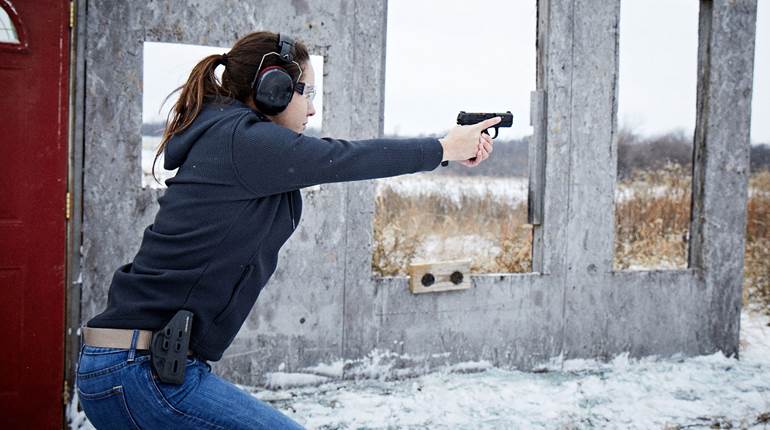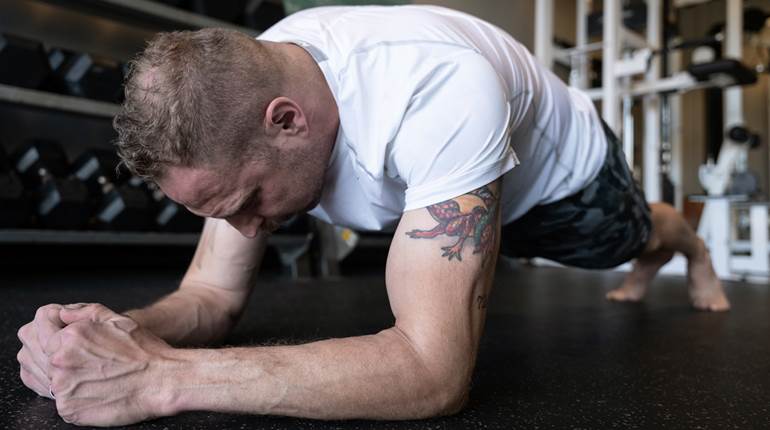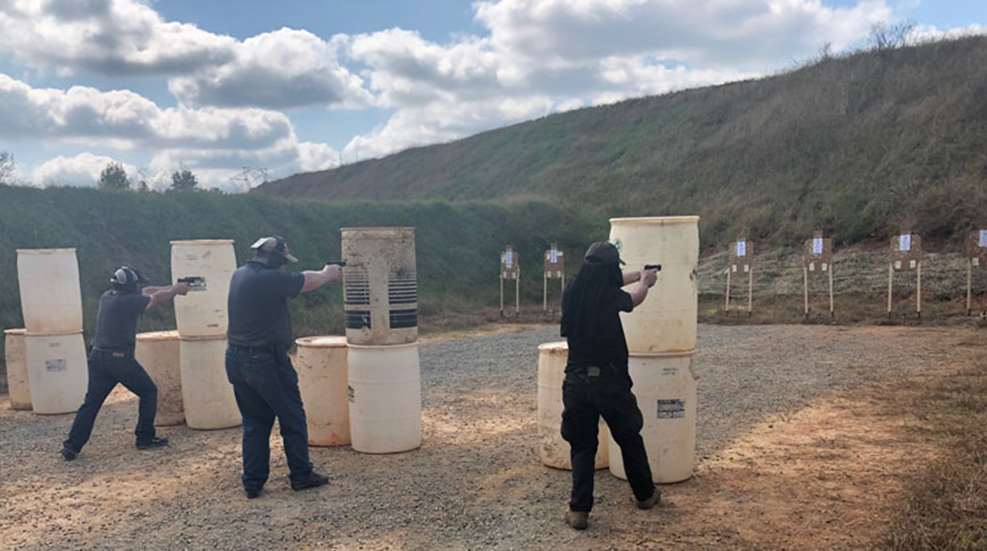
Organization/Trainer: Handgun Combatives, Dave Spaulding
Contact: handguncombatives.com
Areas of Focus: Essential pistol skills; one-handed shooting/drawing/manipulation (strong and support); shooting at various distances (5 yds. to 25 yds.); shooting from unconventional positions; use of cover
Course Duration: Two Days (16 hours)
Round Count:
Projected: 600
Actual: 556
Equipment Used:
Pistol: Smith & Wesson M&P9 M2.0
Ammunition: Winchester Ammunition, W Train & Defend, 147-gr. FMJ
Holster: Bravo Concealment BCA OWB Kydex Holster and Kydex Double Magazine Pouch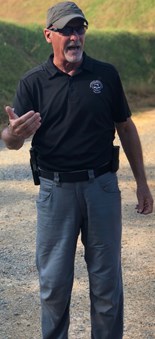
I’ve known Dave Spaulding of Handgun Combatives for a few years now, and I had the opportunity to train with him back in 2016, during a launch event for Ruger’s American Compact pistol at FTW Ranch near Barksdale, Texas. Rather than inviting gun writers for a simple show and tell, Ruger wisely decided to bring in an expert in the field of armed personal protection to put those writers, and the new gun, through their paces. Spaulding, a career law enforcement officer, graduate of countless shooting schools and a nationally acclaimed firearms instructor for law enforcement personnel and armed citizens, certainly fit the bill. What followed was two days of high round counts, a lot of learning and a lot of fun as attendees shot their way through a modified version of Dave’s foundational Combative Pistol course.
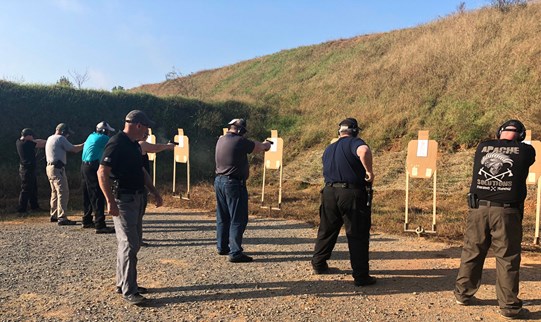
I enjoyed Dave’s demeanor as an instructor—patient, safety-conscious and quick with a joke—and I agreed with his overall philosophies, which emphasize the essentials of pistolcraft to achieve accuracy, and biomechanical efficiency to improve speed. Handgun Combatives is also very student focused, it’s not all about Spaulding or his methods—he’ll be the first to tell you not to fall in love with any one “way” of doing things—rather, the lesson blocks include tasks and challenges relevant to the combative application of a pistol, and Spaulding gradually chunks the skill sets together to achieve holistic results measured by improved performance and a deeper understanding of the concepts.
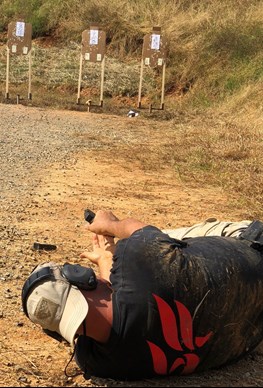 Based on my experience in Texas with Handgun Combatives, training with Spaulding again was on my “To Do” list, and an opportunity arose when he scheduled an Adaptive Combative Pistol course at a range outside of Richmond, Va., only about a two-hour drive for me. According to the Handgun Combatives website, “This course will review essential combat shooting skills, and their place in armed conflict, and then advance to required tactics and techniques to prevail. Use of cover, unconventional shooting positions, one hand shooting/drawing/manipulation, close contact shooting positions and decision making/cognition drills and skills will be emphasized.” I’d suggest that the real strength of this course is the emphasis on performing essential skills under adverse or compromised conditions—e.g. using one arm due to injury; having to start, or continue, your fight from the ground; or needing to make critical shots at increasing distances. (Spaulding considers any fight within 25 yds. to be a close-quarters encounter, therefore shooting exercises from that distance are a typical occurrence during Handgun Combatives courses.)
Based on my experience in Texas with Handgun Combatives, training with Spaulding again was on my “To Do” list, and an opportunity arose when he scheduled an Adaptive Combative Pistol course at a range outside of Richmond, Va., only about a two-hour drive for me. According to the Handgun Combatives website, “This course will review essential combat shooting skills, and their place in armed conflict, and then advance to required tactics and techniques to prevail. Use of cover, unconventional shooting positions, one hand shooting/drawing/manipulation, close contact shooting positions and decision making/cognition drills and skills will be emphasized.” I’d suggest that the real strength of this course is the emphasis on performing essential skills under adverse or compromised conditions—e.g. using one arm due to injury; having to start, or continue, your fight from the ground; or needing to make critical shots at increasing distances. (Spaulding considers any fight within 25 yds. to be a close-quarters encounter, therefore shooting exercises from that distance are a typical occurrence during Handgun Combatives courses.)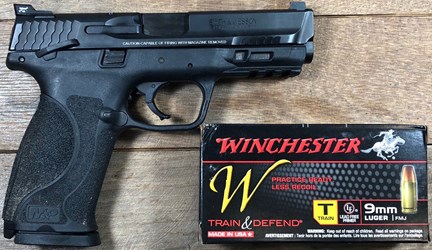
To shoot this course I turned to one of the best pistols out there today (my opinion, of course), Smith & Wesson’s M&P9 M2.0. I decided to shoot the course with the full-size model (4.25” barrel) and I had the Compact (4” barrel)—my regular concealed carry pistol—on hand as a backup. For these guns I had the Bravo Concealment BCA outside the waistband (OWB) holster, which as far as kydex OWB rigs go, is one of the most durable and concealable options I’ve used. For 9 mm Luger ammunition, I brought the 147-gr. FMJ load from Winchester’s W Train & Defend line—a well-engineered, reduced-recoil training load that remains relatively affordable. For those unfamiliar, Winchester’s “T” (for Train) ammunition can be paired with a ballistically matched “D” (for Defend) load—featuring a 147-gr. JHP in the 9 mm Luger option—for those who want consistency in feel and performance between their practice and carry ammunition.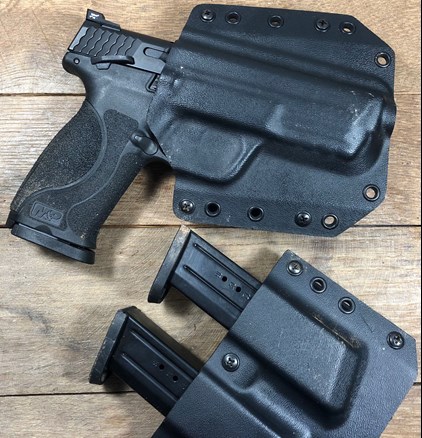
Thus equipped, it was off to the range.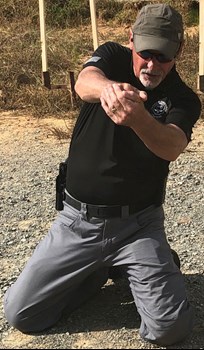
As with most shooting schools, Adaptive Combative Pistol begins with a classroom briefing—a introduction of the instructor, a range/facility safety brief, an overview of fundamentals and essential knowledge, and a preview or “theoretical” explanation of the skills that are going to be taught during the class. One of my notes from the classroom portion of the course included a definition, “Adaptive—The ability to change as necessary.” This would prove to be a pillar of the live-fire training as we learned to change the way we perform essential skills in order to overcome those aforementioned adverse conditions. Another note I made reads, “Speed & Accuracy,” followed by, “Efficiency—the least amount of time, effort and energy expended.” This harkens back to the foundations of Spaulding’s instruction—essentials to achieve accuracy, efficiency to improve speed.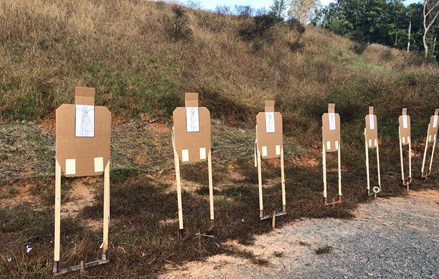
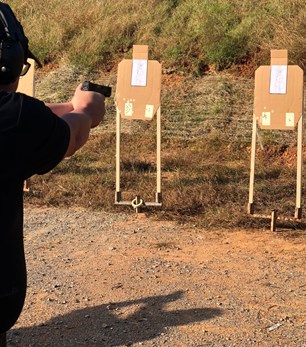 I’m not going to go into a blow-by-blow, or drill-by-drill as it were, recap of the course; if you want to experience the full curriculum, you’re going to have to step up and take the class yourself. I will, however, discuss a few of my takeaways and offer some advice. Let’s start with the fun stuff—gear. There were 16 students in the class I attended; of those, 11 were using Glock 19 pistols, including one G19X. Two of us were using Smith & Wesson M&P9s. There was also one SIG P320, one FN 509 (also the only gun using a red-dot optic, a Trijicon RMR) and one Springfield XD in 9 mm. Throughout the courses of fire I experienced zero malfunctions or stoppages—not counting those intentionally induced for training purposes, there were a few of those—and I observed only a few minor hiccups with the other participants’ guns, all of which seemed to be cleared with simple tap-rack remedial actions. There was one gun, a Glock, that went down twice with an obstructed barrel due to squib loads—both occasions involved the same gun and same shooter, and I suspect the issue was ammunition related (probably reloads.) Overall though, the guns really ran great despite the heat—mid-80s with full-value humidity—sweat, dirt, high round counts and many shots fired with weak-hand grips or from less-than-ideal shooting positions. What’s the lesson here? All the guns on the line were quality pistols from respected manufacturers, so it’s no surprise that, when loaded with quality ammunition, they ran great. Also, you don’t have to break the bank in order to get a very good defensive firearm that will perform in adverse conditions—the average pistol MSRP from this class was probably $500-$600. If you are in the market, get a proven pistol design from a trusted maker and some quality ammunition. Then get training.
I’m not going to go into a blow-by-blow, or drill-by-drill as it were, recap of the course; if you want to experience the full curriculum, you’re going to have to step up and take the class yourself. I will, however, discuss a few of my takeaways and offer some advice. Let’s start with the fun stuff—gear. There were 16 students in the class I attended; of those, 11 were using Glock 19 pistols, including one G19X. Two of us were using Smith & Wesson M&P9s. There was also one SIG P320, one FN 509 (also the only gun using a red-dot optic, a Trijicon RMR) and one Springfield XD in 9 mm. Throughout the courses of fire I experienced zero malfunctions or stoppages—not counting those intentionally induced for training purposes, there were a few of those—and I observed only a few minor hiccups with the other participants’ guns, all of which seemed to be cleared with simple tap-rack remedial actions. There was one gun, a Glock, that went down twice with an obstructed barrel due to squib loads—both occasions involved the same gun and same shooter, and I suspect the issue was ammunition related (probably reloads.) Overall though, the guns really ran great despite the heat—mid-80s with full-value humidity—sweat, dirt, high round counts and many shots fired with weak-hand grips or from less-than-ideal shooting positions. What’s the lesson here? All the guns on the line were quality pistols from respected manufacturers, so it’s no surprise that, when loaded with quality ammunition, they ran great. Also, you don’t have to break the bank in order to get a very good defensive firearm that will perform in adverse conditions—the average pistol MSRP from this class was probably $500-$600. If you are in the market, get a proven pistol design from a trusted maker and some quality ammunition. Then get training.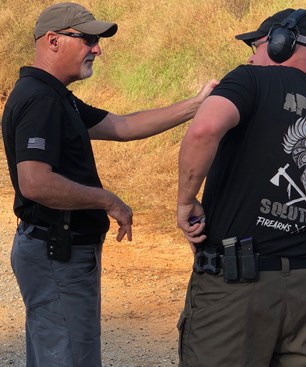 Takeaway, the second: You don’t know what you don’t know. Adaptive Combat Pistol is an exercise in performing essential pistol skills—skills you are likely familiar with and adept at performing in a controlled environment—but doing so under adverse conditions. And there is no way to know how best to perform those necessary actions under those conditions until you try it. Can you draw your firearm from concealment with just your support hand? I found that 3-o’clock strong-side carry was far less suited to this task than appendix or FBI carry. However, others with narrower backs and chests had no problem. What if you start your fight from the ground, can you access all your gear if you are lying on your back? Or, what if you need to reload one-handed, where do you put the gun? Between the legs or clenched behind a knee work pretty well. What if you are already kneeling or prone? The ground isn’t going anywhere and it holds a pistol pretty well—put the piece down, grab your magazine and get back to work. How about performing remedial action after stoppages? I’ve got news for you, in some circumstances during a fight, you are not going to be able to clear a bad stoppage, and you’ve got to prepare mentally for what your next contingency may be. The examples go on, and Adaptive Combat Pistol does a good job of forcing participants to consider and work through a variety of undesirable circumstances in order to perform the skills essential to pistolcraft.
Takeaway, the second: You don’t know what you don’t know. Adaptive Combat Pistol is an exercise in performing essential pistol skills—skills you are likely familiar with and adept at performing in a controlled environment—but doing so under adverse conditions. And there is no way to know how best to perform those necessary actions under those conditions until you try it. Can you draw your firearm from concealment with just your support hand? I found that 3-o’clock strong-side carry was far less suited to this task than appendix or FBI carry. However, others with narrower backs and chests had no problem. What if you start your fight from the ground, can you access all your gear if you are lying on your back? Or, what if you need to reload one-handed, where do you put the gun? Between the legs or clenched behind a knee work pretty well. What if you are already kneeling or prone? The ground isn’t going anywhere and it holds a pistol pretty well—put the piece down, grab your magazine and get back to work. How about performing remedial action after stoppages? I’ve got news for you, in some circumstances during a fight, you are not going to be able to clear a bad stoppage, and you’ve got to prepare mentally for what your next contingency may be. The examples go on, and Adaptive Combat Pistol does a good job of forcing participants to consider and work through a variety of undesirable circumstances in order to perform the skills essential to pistolcraft.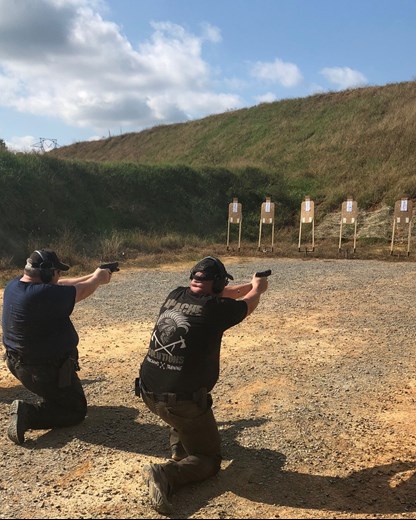
Overall, Handgun Combatives Adaptive Combat Pistol course is not about teaching a series of procedures or techniques to perform in defined scenarios—there are no “forms” or katas. Instead, the intent is to introduce a wide range of realistic obstacles, obstructions and adverse conditions so that the students can develop a mindset that will allow them to adapt, to change as necessary, in order to perform the skills required to prevail in a life-and-death encounter. I found the class to be incredibly engaging, well-taught and a lot of fun. For those interested, I’d whole-heartedly recommend Handgun Combatives Adaptive Combat Pistol, or any Handgun Combatives course. In fact, I look forward to training with Dave again; I’d really like to take his Kinetic Combat Pistol course.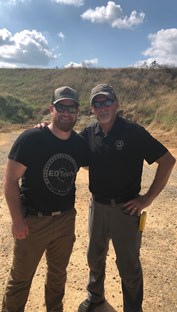
Finally, some advice. If you’re planning to go to gun school, and you should, go with an open mind. This is particularly true of courses teaching more advanced skills, courses with narrow or specific skill focuses, and courses taught by well-established instructors and schools. “When in Rome, do as the Romans do.” Be respectful, be open and embrace the methods and philosophies being taught—you’ll have time to evaluate their worth and act accordingly after the class concludes. On the other hand, don’t be afraid to ask why something is being done or being taught a certain way. Ask respectfully, and any instructor worth their salt will have a good answer.
For more information about Dave Spaulding and Handgun Combatives, including courses and schedules, check out handguncombatives.com.












